Introduction to an Average Size of Master Bedroom Walk In Closet:
A cornerstone of modern interior design, a walk-in closet is a crucial storage area typically found in or near a bedroom. It’s essential in a master bedroom because it provides ample space for storage to organize clothing, shoes, accessories, and other items, helping to keep the room tidy and clutter-free.
It typically features shelves, hanging rods, drawers, and other organizational elements to maximize storage capacity and organization. Walk-in closets offer more space and convenience compared to traditional closets, allowing individuals to easily see and access their belongings.
In this article, we will discuss 15 key factors essential for understanding the basics of an average size of master bedroom walk in closet. We will also cover factors such as walk-in closet dimensions, material selection, cost analysis, storage needs, layout considerations, and practical tips for optimizing the use of your walk-in closet space.
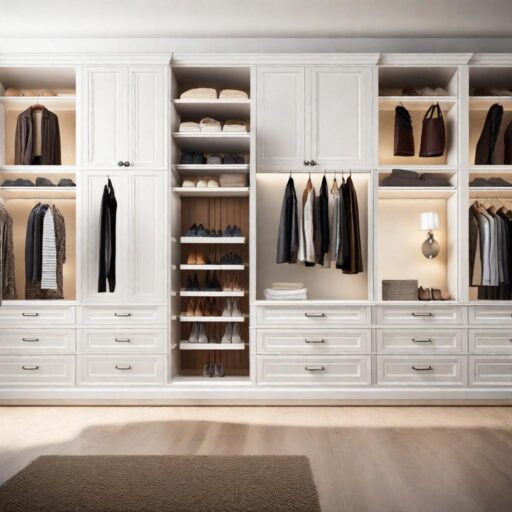
1. Typical dimensions of an average size of master bedroom walk in closet:
When it comes to the question, what is the average size of a master bedroom walk in closet? The answer is to consider the dimensions of the overall size of the master bedroom.
For smaller master bedrooms, the walk-in closet may typically measure around 12 to 14 inches wide from the wall, 5 to 8 feet in length from one wall to another, and 7 to 8 feet in height to maximize space without overwhelming the room.
In medium-sized master bedrooms, you might find walk-in closets ranging from 14 to 16 inches wide, 8 to 10 feet in length, and 8 to 9 feet in height, providing a balance of storage capacity and room aesthetics.
For larger master bedrooms, the walk-in closet could span 16 to 18 inches wide, 10 to 12 feet in length, and 9 to 10 feet in height, offering generous storage space while complementing the expansive layout of the room.
2. Material Selection:
When choosing materials for the average size of a master bedroom walk in closet, common materials options include wood, MDF, particle board, wire shelving, laminate, front door glass, and metal. Wood offers durability and a classic look, MDF is known for its durability, making it a popular choice, and particle board is cost-effective and versatile. Wire shelving is lightweight and allows for better ventilation, while laminate provides customizable design options. Metal hardware, like stainless steel, is durable and modern.

3. Cost Considerations:
Wood is durable but expensive, especially high-quality hardwoods like oak or cherry. The cost of MDF is relatively low compared to solid wood, and particle board is budget-friendly, offering versatility and durability. Wire shelving is the most affordable option, lightweight, and easy to install.
Laminate provides customizable designs at a reasonable cost, easy to clean and maintain. Metal hardware, like stainless steel, is durable and modern, adding a sleek touch at a relatively affordable price. Consider your budget and desired aesthetics when choosing materials for your walk-in closet.
4. Assess Storage Needs:
Before beginning the planning process, it’s essential to assess the storage needs of all family members living in a bedroom. Take inventory of all clothing, shoes, accessories, and other items to determine the type and size of storage space required. This step ensures that the walk-in closet design caters to everyone’s belongings, optimizing organization and accessibility for all.
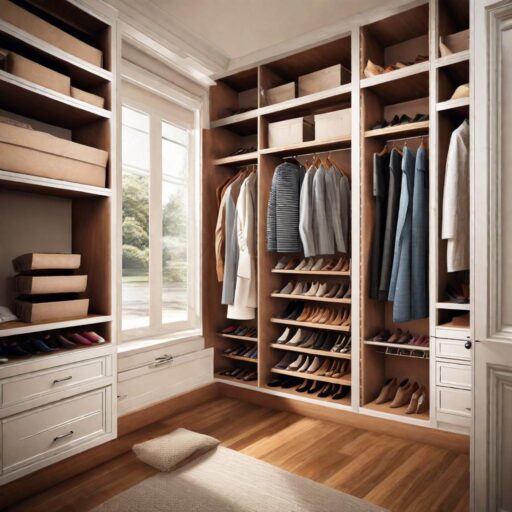
5. Evaluate Available Space:
Measure the dimensions of your master bedroom, where the walk-in closet will be built, or measure the existing walk-in closet that you will want to be upgraded, measures sizes including width, length, and height. Consider any architectural features or obstructions that may impact the layout, such as windows, doors, or sloped ceilings.
6. Create a Layout:
When designing your walk-in closet layout, focus on optimizing the available space to meet your storage requirements effectively. Divide the closet into separate zones for different types of items, including hanging clothes, folded items, shoes, accessories, and other miscellaneous items. By creating designated zones, you can maximize organization and accessibility within the closet, ensuring that each category of items has its dedicated space.
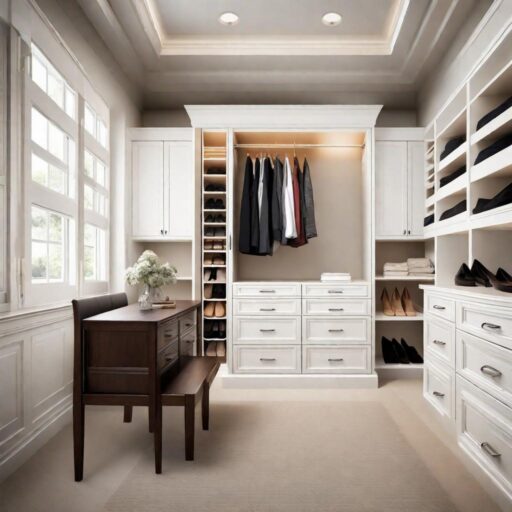
7. Maximize Vertical Space:
Utilize vertical space efficiently by installing floor-to-ceiling shelving or stacking storage units. This allows you to make the most of your closet’s height, effectively doubling or even tripling your storage capacity. With floor-to-ceiling shelving, you can store items like folded clothing, shoes, handbags, and bins containing accessories or seasonal items. Stacking storage units are also ideal for organizing items such as shoes, folded clothing, and storage bins.
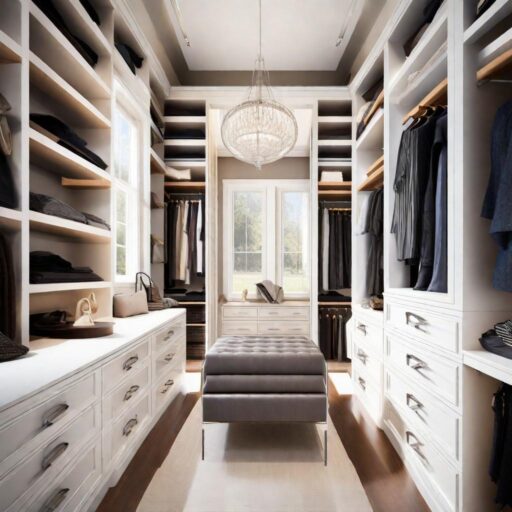
8. Customize Storage Solutions:
Invest in customizable storage solutions such as modular shelving systems, adjustable hanging rods, and drawer organizers. These allow you to tailor the closet layout to suit your specific needs and preferences. With these adjustable features, you can easily accommodate different types of clothing, accessories, and other items, ensuring efficient organization and maximizing the usability of your closet space.

9. Utilize Corner Space:
Don’t overlook corner space, which can often be underutilized. Install corner shelves or hanging rods to make the most of this area and increase storage capacity. Utilize this area to store folded clothing, shoes, handbags, or accessories like hats and scarves. By optimizing corner space, you can increase your closet’s storage capacity and keep all your belongings neatly organized and easily accessible.

10. Incorporate Built-In Features:
Consider incorporating built-in features like drawers, cubbies, and pull-out racks in your walk-in closet. These elements offer efficient storage solutions for various items. Use drawers to store folded clothing, socks, or accessories like belts and jewelry. Cubbies are perfect for organizing shoes, handbags, or folded sweaters. Pull-out racks are ideal for hanging ties, scarves, or belts, ensuring easy access and keeping everything neatly organized.

11. Add Accessories:
Enhance the functionality of your average size of master bedroom walk in closet by integrating accessories like hooks, baskets, and jewelry organizers. These additions offer versatile storage solutions for smaller items, ensuring everything has its place and keeping the closet tidy and organized. Hooks are ideal for hanging hats, scarves, or bags, while baskets can corral socks, scarves, or miscellaneous accessories. Jewelry organizers keep your necklaces, bracelets, and earrings neatly separated and easy to find.
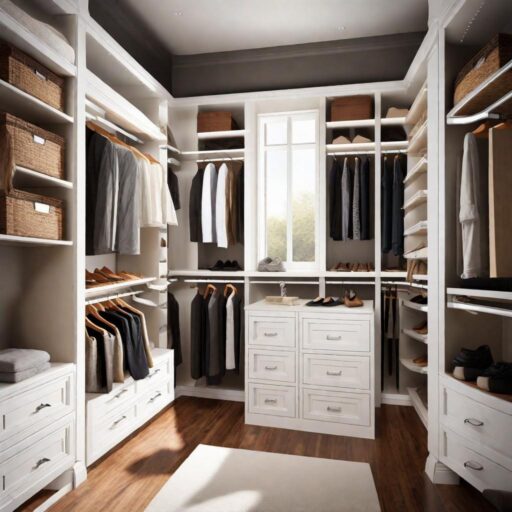
12. Prioritize Accessibility:
Arrange frequently used items at eye level or within easy reach in your walk-in closet to ensure accessibility. Keep everyday essentials like shoes, handbags, and frequently worn clothing items at this level for convenience. Reserve higher or lower shelves for storing seasonal or less frequently used items such as out-of-season clothing, extra bedding, or special occasion accessories.
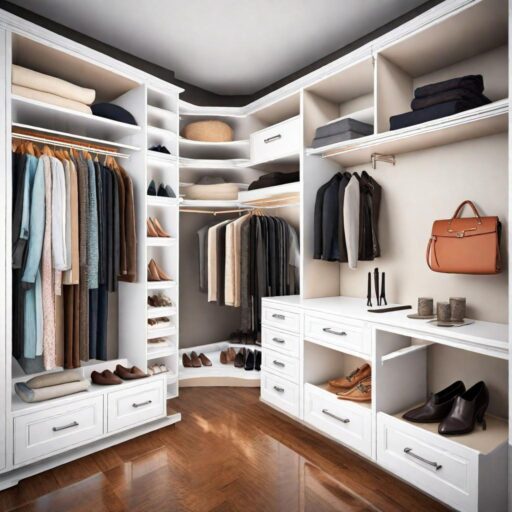
13. Optimize Lighting:
Proper lighting is crucial for visibility and functionality in your walk-in closet. Consider installing overhead lighting or LED strip lights to illuminate the space effectively. This ensures that you can easily locate items and navigate your closet with ease. Overhead lighting provides general illumination, while LED strip lights offer targeted lighting for specific areas, such as shelves or hanging rods.

14. Maintain Flexibility:
When designing your walk-in closet layout, prioritize flexibility to accommodate future changes or adjustments. Opt for modular storage solutions that can be easily reconfigured as your storage needs evolve. Modular units allow you to adapt the layout to suit changing preferences or requirements without major renovations.
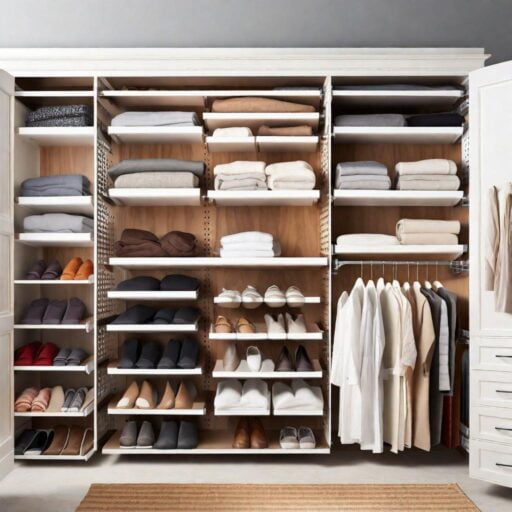
15. Tips for Optimal Use:
To optimize space in your walk-in closet, maximize vertical storage with shelves and hanging organizers. Rotate seasonal items and regularly declutter to maintain tidiness. Utilize the back of the door for additional storage and label shelves for easy identification. Ensure adequate lighting and schedule regular maintenance to keep the closet organized and functional. Incorporating these simple tips will help you make the most of your closet space and keep it clutter-free.
Conclusion:
In summary, this blog post has provided valuable insights into the average size of master bedroom walk in closet. By discussing key factors like dimensions, material selection, cost analysis, storage needs, layout considerations, and optimization tips, we’ve aimed to help readers understand the importance of creating a functional and efficient storage space in their homes.
Whether you’re embarking on a new closet project or seeking to improve an existing one, our comprehensive guide offers practical advice to assist you in designing a well-organized and stylish walk-in closet that suits your lifestyle and preferences.
FAQs (Frequently Asked Questions)
1. What is the average size of a master bedroom walk in closet?
When determining the size of a master bedroom walk-in closet, match it to the room’s dimensions. For smaller bedrooms, aim for 12-14 inches wide, 5-8 feet in length, and 7-8 feet in height. Medium-sized rooms fit closets 14–16 inches wide, 8–10 feet in length, and 8-9 feet in height. Larger bedrooms suit closets 16-18 inches wide, 10-12 feet in length, and 9-10 feet in height.
2. What is the average size of a master bedroom?
Here are the sizes for the three standard master bedrooms:
Smaller master bedroom: Typically, around 10 feet by 12 feet.
Medium-sized master bedroom: Typically, around 12 feet by 14 feet.
Larger master bedroom: Typically, around 14 feet by 16 feet.
3. How can I maximize space in a small walk-in closet?
To maximize space in a small walk-in closet, consider utilizing vertical storage with shelves and hanging organizers. Additionally, declutter regularly to optimize available space.
4. What are some cost-effective storage solutions for a walk-in closet?
Cost-effective storage solutions include modular shelving systems, wire baskets, and DIY storage solutions.
5. Are walk-in closets a worthwhile investment for homeowners?
Yes, walk in closets are considered a worthwhile investment as they add value to the home and enhance convenience and organization for homeowners.
6. Can I install a walk-in closet in an existing bedroom?
Yes, you can! Consult with a professional to assess the feasibility and design options for incorporating a walk-in closet into your existing bedroom layout.
7. How can I update my walk-in closet on a budget?
Consider DIY projects, such as painting or installing new shelves. Shop for affordable organizational tools and storage solutions, and repurpose existing items to freshen up the space without breaking the bank.
8. What if my master bedroom is small? Can I still have a walk-in closet?
Yes, you can! Optimize space by utilizing vertical storage solutions and choosing compact organizers to maximize storage capacity while fitting within the room’s dimensions.
9. How do I make the most of a small walk-in closet?
Use space-saving organizational tools like hanging organizers, slim hangers, and stackable bins. Declutter regularly and prioritize essentials to make the most of limited space.
10. How often should I clean and organize my walk-in closet?
It’s recommended to clean and organize your walk-in closet at least once every season to maintain cleanliness and organization.
